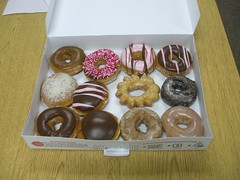Dear Abby,
You called and asked if you could interview me for your Saint Catherine’s Library School assignment. Being asked for an interview is sort of like an invitation I received to speak at a 25th high school reunion in a school where I used to be a teacher. Not only are my students 25 years out of school, they’re inviting me back as an old teacher (do they expect me to use a walker?). Sort of makes me feel older than dirt – or at least an elder of the tribe. But anyway, I take my commitment to the future of our profession very seriously. So seriously, that while I readily gave you answers to your list of questions, after some thought I’d like to change (or at least re-arrange) my answer.
You asked, “What problems and challenges does [my] library system face?” Of course, my number one answer addressed not-enough-funding. I responded, “Demonstrated increasing service needs in absence of corresponding increasing funding.” Continuing, my answers 2, 3, and 4 respectively addressed delivering techy services simultaneously with traditional services, finding new ways to provide outreach services, and providing a diverse high quality collection. And my very last answer (#5) was, “Employing, inspiring, and equipping visionary, customer service-oriented library staff – both in leading current staff and hiring new staff.”
4 days after giving you that answer, I’d like to rearrange my responses and move #5 to #1. Yes, funding is important, but I propose that our greatest resource is our staff, and the care and feeding of staff resources is the job of the Director. Take care of the staff, and the staff will take care of the business.
Staff leadership is a daunting task. Modeling energy and enthusiasm is a real challenge some days. Sometimes you lead from the front, more often from alongside and occasionally from behind. Even terrific employees need continual nurturing through support and training to equip them to carry out ordinary tasks in extraordinary ways and inspire their visions of how to provide services better. And when people move on, the challenge of finding the right person to bring in a fresh perspective is too often not easy, but a real opportunity. We get many applicants, but many misunderstand or ignore the minimal requirements for the job. But at the end of the day, it’s a real reward to see the staff functioning as a team, in tune with the community and each other.
Funding problems will always be here (or at least they’ve been with us as long as I can remember). But I really believe that an efficiently staffed organization, maximizing the resources we have to provide the most appropriate services we can, is the best possible marketing tool to prove that we’re worthy of the funding we get -- and hopefully to inspire the trust to continue to receive.
So, thanks for asking. It gave me a real opportunity to reflect and remember why I love this job. Good luck in your library career!
Labels: leadership, librarianship, marketing



